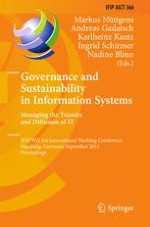2011 | Book
Governance and Sustainability in Information Systems. Managing the Transfer and Diffusion of IT
IFIP WG 8.6 International Working Conference, Hamburg, Germany, September 22-24, 2011. Proceedings
Editors: Markus Nüttgens, Andreas Gadatsch, Karlheinz Kautz, Ingrid Schirmer, Nadine Blinn
Publisher: Springer Berlin Heidelberg
Book Series : IFIP Advances in Information and Communication Technology
